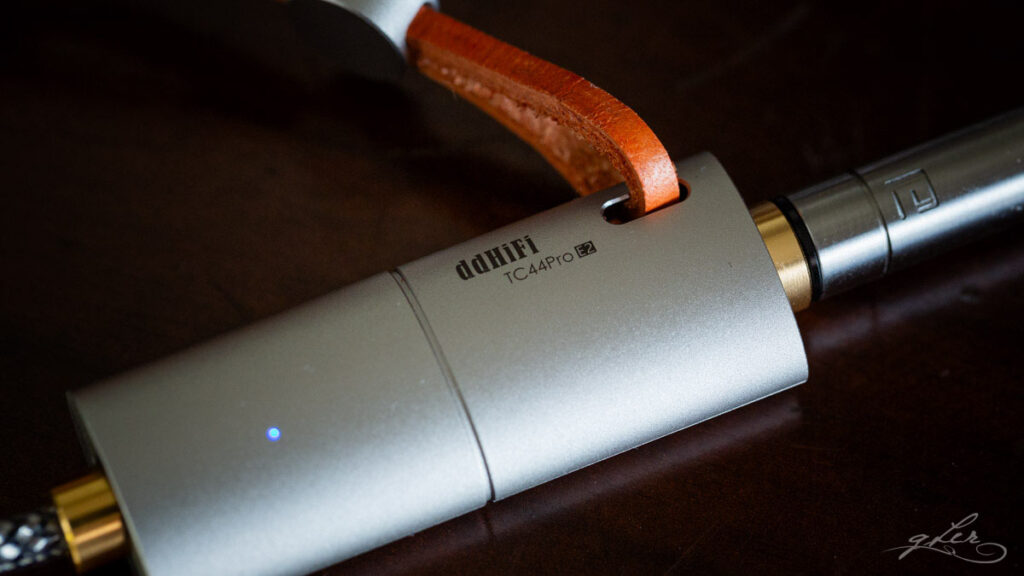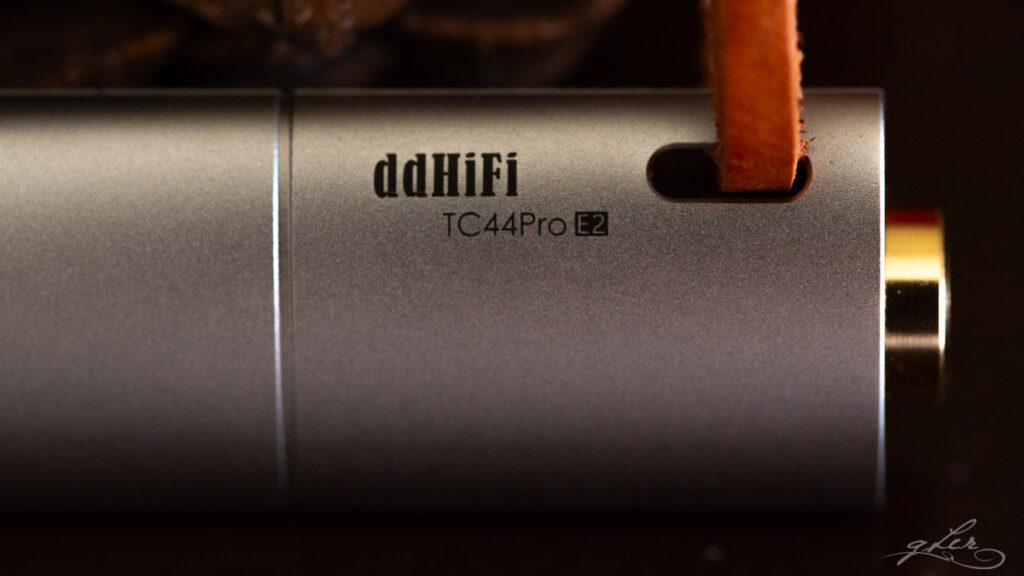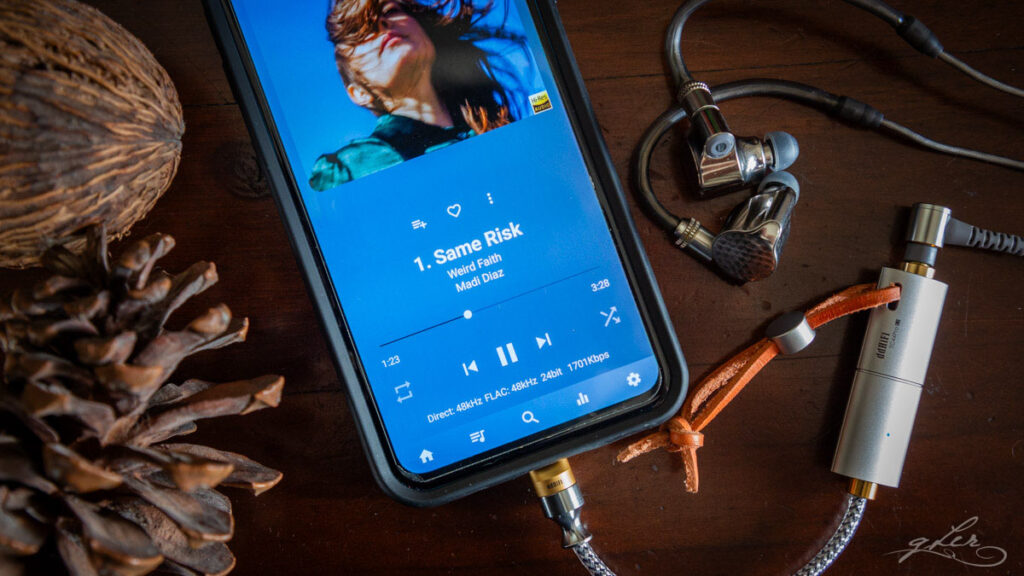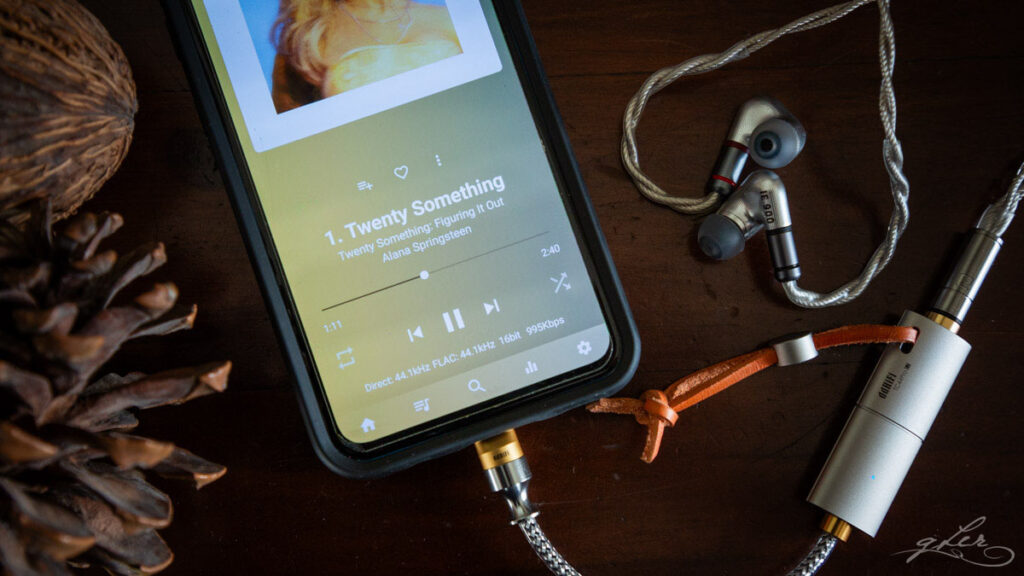While discussing ddHiFi’s new CZ300 and CZ180 cases (reviewed here) with the always-friendly Lily, I noticed the popular Chinese accessory maker recently released the second generation of its ‘Eye’ 4.4mm audio dongle: the TC44Pro E2.
It was actually the design that caught my eye (wink, wink): a stylish, polished silver cylinder with a gold-plated 4.4mm audio port on one side (hence the eye) and a fixed USB-C cable on the other (the TC44Pro E2 is also available with a Lightning cable for those still using legacy iPhones). It also had some sort of funky leather attachment that seemed more decorative than functional, but the fact that it stood out in the design means it’s already served its purpose.
So, I asked Lily if she wouldn’t mind sending me one to review, even though I generally don’t use dongles for my personal music listening. That might change now that this little guy is permanently in my bag.

Packaging, accessories and design
TC44Pro E2 is packaged similarly to ddHiFi’s TC07S USB-C OTG cables – and also, incidentally, features the same 10cm Nyx-series high-purity silver plated audiophile-grade cable. There’s not much to the packaging: an attractive square white box with an illustrated slipcover. The TC44Pro E2 is wrapped inside a translucent plastic sleeve, along with a second smaller sleeve with an extra length of cowhide.
That cowhide, which I mentioned earlier, doubles as a cable tie, so you can bend the flexible cable and hook it in the leather loop to make the overall footprint smaller for storage. The dark brown and tan leather strap is raw on the one side and finished smooth on the other, and provides an appealing contrast with the polished silver of the dongle.
If you’re not into leather, or find the cable tie idea obtrusive, it’s easy enough to undo the ‘snake knot’ and remove the strap. You can always put it back together again by scanning the QR code on the plastic sleeve the dongle came in, which directs you to a short video tutorial on tying a snake knot. Very cute, but little more than a sideshow to the main event.

The dongle itself is cylindrical, with the main body (which houses the electronics and analogue circuits) measuring 60mm in length and about 10mm at its thickest point. Overall length is 180mm with the attached cable. The cylinder is grooved in the middle, presumably made of two separate DAC and amp sections fused together, with a small LED light in the section closest to the cable. The light glows different colours, depending on the output format (blue for PCM, green for DSD).
Build quality is extremely high, especially for the $99 sticker price. You can see the machining is ultra-precise, with smooth edges, clean contacts, and an evenly-polished surface that’s silky cool to the touch. The connectors at either end – USB-C male and 4.4mm female – are both gold-plated and very sturdy, and fit with a tight, wiggle-free click. The all-metal housing looks and feels like it’s built to last, aside from being visually stunning.
While the cable, cylinder and connectors might look more substantial than smaller dongles, they’re actually comparatively compact and very light, and I don’t see bulk being a problem at all. Considering this dongle is designed specifically for IEMs with 4.4mm balanced cables, the attached cables and IEMs are always more likely to be bulkier than the dongle itself.

This is a no-frills device. You plug it in, enable USB-C DAC support from the popup window on your smart device (or switch to the TC44Pro E2 option in your PC or Mac’s sound settings), and off you go. There are no buttons to press, no volume dial, no filters to toggle, no gain settings to switch between; just plain old straightforward DAC/amp functionality.
I even like that there’s a single balanced output port; if you’re not primarily using 4.4mm cables with your IEMs, the balanced circuit is basically wasted, so rather choose from one of the many other single-ended dongle options available on the market.
Sound impressions
For a sleek, stylish, device-powered dongle, the TC44Pro E2 is rather beefy on the inside:
- DAC: CS43131 × 2
- AMP: ES9603Q × 2
- Rated power: 250mW (32Ω load)
- SNR: >125 dB
- Dynamic range: >120dB
- THD+N: <0.0004% @1kHz
- Format support: PCM up to 32-bit / 384kHz, native DSD up to DSD256
Sure, these aren’t really numbers that are going to sway you from using a more powerful and full-featured DAP, but that’s not what this type of product is for. It’s arguably a solid upgrade for most smartphone audio systems – even flagship smartphones – doesn’t force you into using adapters for your pricey 4.4mm cables, and is far better suited to higher-end IEMs than the basic dongles that ship with your phone.

I tested the TC44Pro E2 using a variety of test tracks on my LG smartphone, with USB Audio Pro as the playback app (which natively recognises the DAC chips and bypasses Android’s sample rate conversion for true hi-res playback).
Using a variety of different IEMs, I mostly limited the tests to two of my harder-to-drive favourites: Sony’s IER-Z1R and Sennheiser’s IE900. Thankfully, it drove both of them with ease, possibly not to their very fullest potential, but with plenty of headroom to spare.
I hear the TC44Pro E2 to have a very clean, transparent tonality, one that emphasises clarity over warmth. Bass notes stand out against the dark background, with well-defined punch and substantial rumble when called for. There’s no bloominess to the bass, nor does it feel soft and pillowy, quite the opposite in fact. There’s a slight bass elevation in the tuning, but nothing that makes the dongle stand out as a particularly bassy device.

Midrange notes are likewise clean, being neither too full or too thin, and fairly well separated. Female vocals have a crispness to them, and perhaps a slight dryness at times, although I wouldn’t call this a dry sound. I just think it lacks the warmth or earthiness of some other devices I’ve heard, being mostly colourless by comparison. There’s a solid weight to instrument fundamentals and male vocals, so I don’t feel like the sound leans too analytical either.
Treble is on the smoother side, without any obvious emphasis. There’s some decent sparkle in the upper registers, and subtle highlights are easy to discern. The treble tuning contributes to the sense of space that I’m hearing, with a wide, deep stage that gives plenty of room for notes to formulate then dissipate.
Where the TC44Pro E2 struggles slightly is busier passages, where lots of different elements converge on the stage. It’s not congested in these instances, but doesn’t quite have the composure and refinement of more elaborate and expensive hardware to help separate the wheat from the chaff, so to speak. That said, resolution is very good, and I don’t feel like I’m, missing too many details – especially when I’m not using mutli-kilobuck IEMs in the chain.

Select comparisons
Apple 3.5mm to USB-C adapter (a.k.a Apple Dongle, $15). This is the lowest common denominator hardware when it comes to audio dongles, probably because it’s so ubiquitous, but mostly because it sounds so damn good. Apple started the dongle revolution when it deprived millions of users of a headphone jack on their iPhones, but at the same time, gave those same users an even better alternative.
Compared to the warm, slightly fuzzy, but oh-so-sweet sounding Apple Dongle, the TC44Pro E2 is far more serious, with a crisper, tighter sound, more expansive stage, and significantly more power on tap for less sensitive IEMs. As an iPhone user it may even be too powerful, and if you find that the sound suddenly cuts out when pairing it with your iPhone, you’ve likely exceeded the phone’s power draw limit.
No such issues with Android phones, of course, but all other comparisons to the USB-C version of the Apple Dongle remain the same. The extra $75 for the TC44Pro E2 buys you a bulkier but far better built device, with a native 4.4mm output (I used ddHiFi’s excellent 4.4mm adapter with the Apple Dongle for this test), and all the power you need, along with arguably improved sound quality across all metrics – money well spent if you ask me.

Cayin RU7 ($289). If $75 buys you an Apple Dongle on steroids in the TC44Pro E2, what does an extra $200 or so buy you over and above?
Quite a bit it seems, when it comes to Cayin’s superb 1-bit RU7. This self-powered dongle is larger, thicker and heavier, but still on the small and slim side as far as dongles go. It’s also far more sophisticated, with a discrete 1-bit DAC, a pseudo line-out mode, and up to 400mW of power on tap.
The RU7 also has its own screen, three different all-to-DSD conversions settings (which influences sound quality), and two gain modes, along with separate volume buttons that let you change the volume in 100 single step increments (something I wish was easier to do with the TC44Pro E2).
Despite its hardware credentials, however, RU7 goes for a very different sound profile, which may or may not be to everyone’s liking. It’s a warmer, thicker, more euphonic sound, with softer bass attack, a smoother, more organic midrange, and similarly smooth but possibly even more relaxed treble. By comparison, while TC44Pro E2 sounds slightly less refined, I also hear it to have a bigger stage, slightly better microdetail definition, and harder hitting bass. Vocals are clearer too, albeit not quite as sweetly smooth.

It might well be that you’re after a more sophisticated dongle, and RU7 is definitely that. I don’t actually think the price differential is going to make that much of a difference to those wanting a solid dongle for casual and on-the-go listening from a smartphone, though RU7 definitely has the potential to scale further and drive much less sensitive IEMs and headphones. It’s also more versatile.
But it doesn’t necessarily sound better, and there’s a case to be made for TC44Pro E2 actually having the more likeable, albeit less musical, tonality for many listeners.
Closing thoughts
I’m not a dongle die-hard, so take this review from whence it comes, but in my opinion, ddHiFi has hit one out the park with the TC44Pro E2.
When I picture a ‘perfect’ dongle – something that elevates the sound of my smartphone, that I can use without switching out the balanced cables on all my IEMs (or that forces me into using an adapter), and that is built as well or better than my $1000-plus devices, this is literally it.

Does it have the sound quality of the devices I generally use to listen to music with my high-end IEMs? Of course not, but then, no dongle does, not even the $500 L&P W4, and certainly not the Cayin RU7, no matter how good both of these ‘superdongles’ might be.
In fact, I’d probably be inclined use the TC44Pro E2 more often for its plug ‘n play simplicity, its significantly slimmer profile, and the fact that I don’t have to bother with the thin, flimsy detachable USB cables these dongles come with.
Overall, I find the tonal and technical performance of the TC44Pro E2 not only pleasing but somewhat surprising, especially when you couple it with the stellar build quality and industrial design. It’s a definite step up from basic dongles – even the venerable Apple Dongle – and for less than a Franklin, it probably makes less sense not having one of these in the kit bag.

The ddHiFi TC44Pro E2 is available to buy direct from ddHiFi’s AliExpress store.



